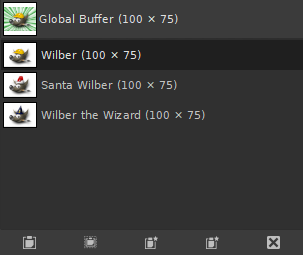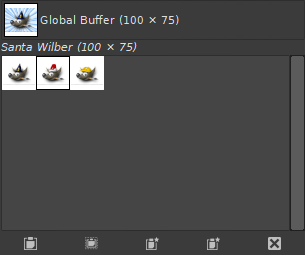Buffers are a kind of temporary storage for image data, created when you cut or copy part of a drawable (a layer, layer mask, etc.). The following commands are available from the menu to save an image to a buffer:
- Вирізання в буфер з назвою…
-
→ → This command cuts the selected part from the current drawable (usually a layer) and places it in a buffer. If there is no selection the whole drawable will be used. You will be asked to give the buffer a name. The image will be removed from the selection after this is done.
- Копіювання з буфера з назвою…
-
→ → This command copies the selected part from the current drawable (usually a layer) and places it in a buffer. If there is no selection the whole drawable will be used. You will be asked to give the buffer a name.
- Копіювати видиме з назвою…
-
→ → This command copies the selected part from all the visible drawables and places it in a buffer. If there is no selection the whole image will be used. You will be asked to give the buffer a name.
- Вставити іменований…
-
→ → This menu command opens the Buffers Dialog. To actually paste a buffer, choose one of the buttons from this dialog, or the context menu. Both of which will be explained below.
The «Buffers» dialog shows you the contents of all existing named buffers, and allows you to operate on them in several ways. It also shows you, at the top, the contents of the Global Buffer (the contents of the clipboard). This Global Buffer is merely a display: you can't do anything with it. There is no hard limit on the number of named buffers you can create, except that it will consume a share of your available computer memory.
![[Застереження]](images/caution.png)
|
Застереження |
|---|---|
|
Named buffers are not saved across sessions: they will be gone when you close GIMP. The only way to save their contents is to paste them into images. |
This dialog is a dockable dialog; see the section Розділ 2.3, «Dialogs and Docking» for help on manipulating it.
Доступ до вікна можна отримати так:
-
from the main menu: → → ;
-
from the main menu: → → ;
-
за допомогою меню вкладки у будь-якому швартованому вікні шляхом натискання кнопки меню вкладки
і вибору пункту → .
In the menu, there is a list of detached windows which exists only if at least one dialog remains open. In this case, you can raise the «Buffers» dialog from the main menu: → .
Clicking on a buffer in the display area makes it the active buffer, i.e., the one that will be used for paste commands executed from the Buffers context menu, or the buttons at the bottom of the dialog. Double-clicking on a buffer causes its contents to be pasted to the active image as a floating selection; this is a quick way of executing the «Paste Buffer» command.
At the bottom of the dialog are five buttons. The operations they perform can also be accessed from the Buffers Menu that you get by right clicking on the active buffer.
In the Tab menu for the «Buffers» dialog, you can choose between and . In Grid mode, the buffers are laid out in a rectangular array. In List mode, they are lined up vertically, with each row showing a thumbnail of the contents of the buffer, its name, and its pixel dimensions.
![[Підказка]](images/tip.png)
|
Підказка |
|---|---|
|
Ctrl+F opens a search field. See View as List |
You can change the size of the buffer previews in the dialog using the «Preview Size» submenu of the dialog's Tab menu.
The button bar at the bottom offers the following functionality:
-
Вставити буфер , Вставити буфер на місце
-
This command pastes the contents of the selected buffer into the active image, as a floating selection. The only difference between this and the ordinary Paste command is that it uses the selected buffer rather than the global clipboard buffer.
With the Shift key pressed, it pastes the buffer at its original location.
-
Вставити буфер до позначеного , Вставити буфер до позначеного на місце
-
This command pastes the contents of the selected buffer into the active image's selection, as a floating selection. The only difference between this and the ordinary Paste Into Selection command is that it uses the selected buffer rather than the global clipboard buffer.
With the Shift key pressed, it pastes the buffer into the active selection at its original location.
-
Вставити буфер як новий шар , Вставити буфер як новий шар на місце
-
This command creates a new layer in the active image out of the contents of the selected buffer. The only difference between this and the ordinary Paste as New Image command is that it uses the selected buffer rather than the content of the global clipboard buffer.
With the Shift key pressed, it creates the layer at the original location of the buffer.
-
Вставити буфер як нове зображення
-
This command creates a new single-layer image out of the contents of the selected buffer. The only difference between this and the ordinary Paste as New Image command is that it uses the selected buffer rather than the content of the global clipboard buffer.
-
Вилучити буфер
-
Ця команда вилучає буфер із вибраною назвою без запитань. Загальний буфер вилучати не можна.





